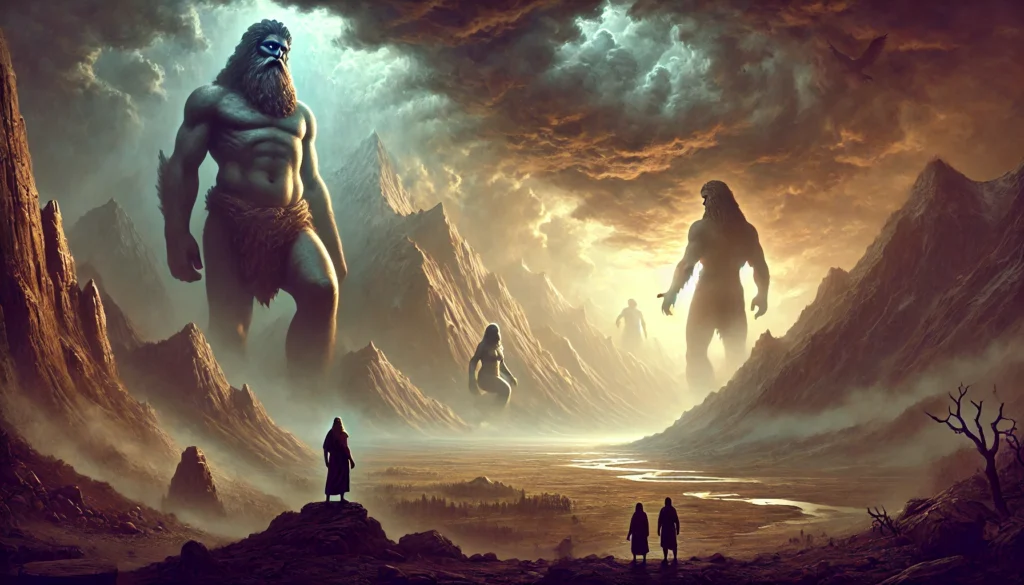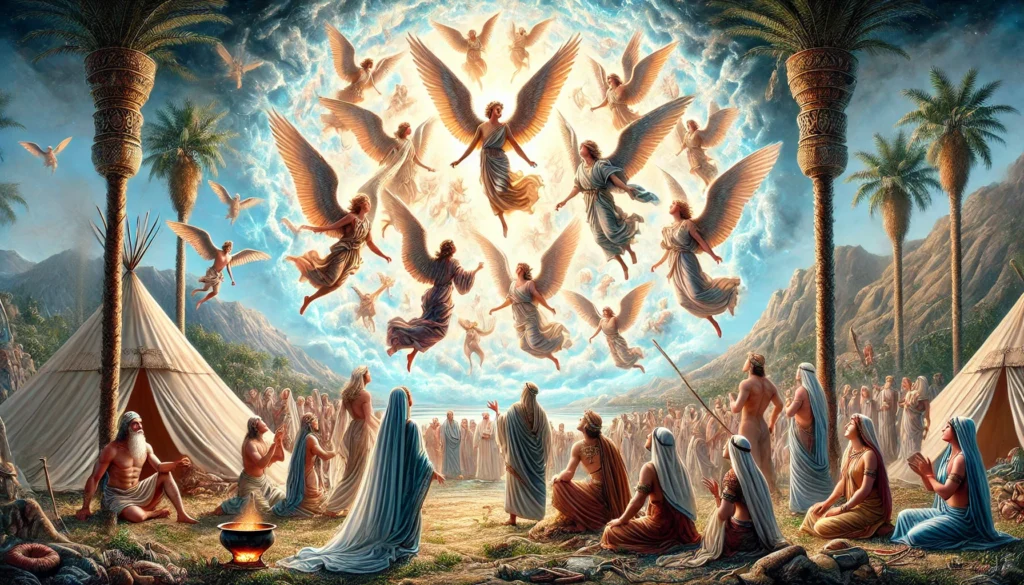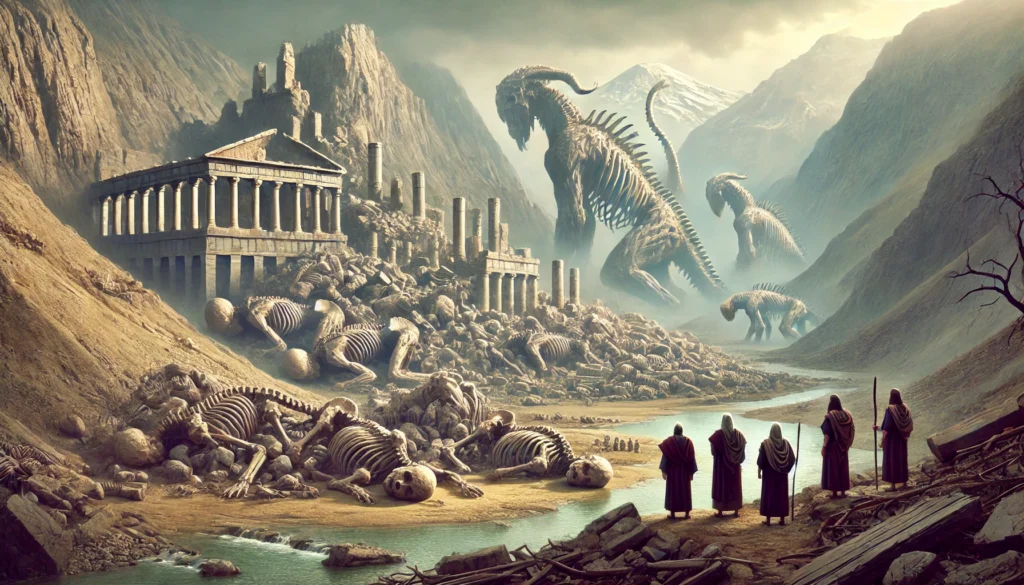Let me take you back to the days before the flood—a time when the earth was wild, untamed, and filled with both promise and peril. Humanity was in its infancy, and the world was unlike anything we can imagine today. Giants walked the earth, mighty beings shrouded in mystery, whose very existence raises questions that echo through the ages. These were the Nephilim. But who—or what—were they?
A Prelude to Giants
In the book of Genesis, the stage is set for their enigmatic appearance:
“The sons of God saw that the daughters of humans were beautiful, and they married any of them they chose. Then the LORD said, ‘My Spirit will not contend with humans forever, for they are mortal; their days will be a hundred and twenty years.’ The Nephilim were on the earth in those days—and also afterward—when the sons of God went to the daughters of humans and had children by them. They were the heroes of old, men of renown.” (Genesis 6:2-4, NIV)

The Nephilim, often translated as “giants” or “fallen ones,” appear in this prelude to the great flood. The Hebrew word Nephilim comes from the root naphal, meaning “to fall.” Were they fallen angels? Mighty warriors? Or something else entirely?
Theories About Their Origins
This passage, while brief, has sparked centuries of debate. Let’s explore some of the most prominent theories about their origins:
1. The Sons of God as Fallen Angels
One popular interpretation is that the “sons of God” were fallen angels who rebelled against heaven. According to this view, these celestial beings took human women as wives, and their union produced the Nephilim—giant hybrids with extraordinary strength and abilities.

This interpretation is elaborated in the Book of Enoch, an ancient Jewish text not included in the standard biblical canon but widely regarded in early Jewish and Christian thought. The Book of Enoch claims these fallen angels not only fathered the Nephilim but also shared forbidden knowledge with humanity, leading to widespread corruption.
2. The Sons of God as Descendants of Seth
Another interpretation sees the “sons of God” as the righteous descendants of Seth, Adam’s son, and the “daughters of humans” as the descendants of Cain, who had turned away from God. The Nephilim, then, were the result of these two lines intermarrying, leading to a corrupt and violent generation.
3. The Sons of God as Rulers or Kings
Some scholars propose that the “sons of God” were ancient rulers or kings who claimed divine lineage. Their relationships with common women produced the Nephilim, who were regarded as heroic figures, renowned for their power and influence.
Giants Across the Land
The Nephilim weren’t just a footnote in the pre-flood era. After the flood, they reappear in the Bible, specifically in the book of Numbers:
“We saw the Nephilim there (the descendants of Anak come from the Nephilim). We seemed like grasshoppers in our own eyes, and we looked the same to them.” (Numbers 13:33, NIV)
The spies sent by the Israelites to scout the Promised Land reported seeing giants, descendants of the Nephilim, living there. These giants were linked to the Anakim and the Rephaim, other biblical groups described as of extraordinary stature (Deuteronomy 2:10-11).

The Nephilim and Ancient Myths
The story of the Nephilim resonates with other ancient traditions. In Mesopotamian mythology, for instance, the Apkallu were semi-divine sages who brought forbidden knowledge to humanity. Similarly, in Greek mythology, the Titans were giant beings born of divine and earthly unions. Could the Nephilim reflect a unique biblical perspective on this ancient archetype?
Were They Literal Giants?
The physical size of the Nephilim is a matter of debate. Were they actual giants, towering over ordinary humans, or was their “greatness” symbolic of their power and influence?
- Literal Giants: Some passages, like those about Goliath (1 Samuel 17:4), suggest that ancient peoples believed in literal giants. Alleged archaeological findings of large skeletons have occasionally fueled speculation, though none have been conclusively verified.
- Symbolic Greatness: Others argue that the Nephilim’s size was metaphorical, signifying their might and renown rather than their physical stature.
The Flood: God’s Response
The story of the Nephilim is intertwined with the narrative of humanity’s corruption. Genesis describes how the wickedness of humanity grew to such an extent that God regretted creating them:
“The LORD saw how great the wickedness of the human race had become on the earth… So the LORD said, ‘I will wipe from the face of the earth the human race I have created.'” (Genesis 6:5-7, NIV)
The flood was God’s judgment, a reset for a world gone astray. The Nephilim, along with the rest of humanity, were swept away—yet their legacy endured in whispers and stories.
Spiritual and Modern Relevance
The mystery of the Nephilim isn’t just an ancient curiosity. It holds lessons for today:
- A Warning Against Pride: The Nephilim symbolize humanity’s tendency to overreach, to seek power and glory apart from God. Their story reminds us of the consequences of pride and disobedience.
- God’s Sovereignty: The flood narrative, though sobering, demonstrates God’s ultimate authority and His desire for righteousness.
- Faith Amid Mystery: The Nephilim remind us that some aspects of Scripture remain mysterious. As believers, we’re invited to trust God even when all the answers aren’t clear.
Shadows of the Past
The story of the Nephilim leaves us with more questions than answers, but perhaps that’s the point. They are shadows of a forgotten time, reminders of humanity’s capacity for both greatness and folly.
How do you see the story of the Nephilim influencing your understanding of faith, mystery, and God’s sovereignty?
Let us walk together through these ancient tales, seeking not just answers, but wisdom and faith to guide our lives today.



